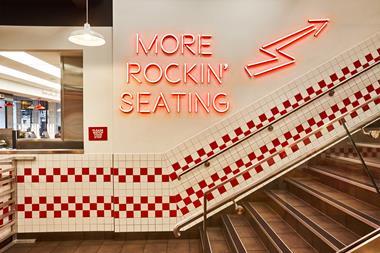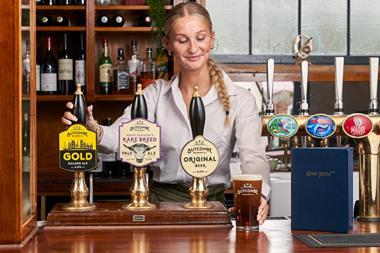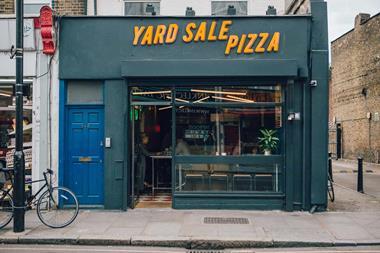Almost a year into his role as chief executive of Mitchells & Butlers (M&B), Phil Urban, who was previously the group’s chief operating officer, is all too aware of the perception of the business from the outside, both positive and negative. “The biggest opportunity here is what everyone always says about M&B: they have some great sites, great brands and some really good people. The opportunity everyone sees from the outside is true and we are fortuitous to sit on the property portfolio we have,” he states. “However, it is underinvested so, equally, the biggest challenge is how quickly you can get that top line moving and there is no silver bullet to that. M&B has been impacted more than most by the sheer volume of new supply/openings that has come into the market over the past few years.”
The company has invested a lot of money on a significant refresh of its IT systems in recent years. Urban says: “Alistair (Darby, Urban’s predecessor) had some tough things to do, changing the IT system was not something you would do lightly, so navigating the business through that process is to his credit and the culture we have today is also to his credit.
“We have got some catching up to do. The foundations are being put in place to do that. I wouldn’t say they are there yet, but they are setting. I am fairly clear on what we need to do and it may be painful getting from A to B, but once we have got through that, the foundations will be there.”
Lack of investment schemes
Urban admits that while the company was sorting out its back of house, including improvements in kitchen management, maintenance and safety, it probably wasn’t doing enough investment schemes. He says: “The company was on a 10 to 11-year investment cycle and equally wasn’t spending enough on the schemes they were doing. While this was happening, competitors were spending sizable amounts as part of faster, more aggressive programmes, we paid the price for that. The biggest challenge is how quickly you can mobilise that new investment cycle and put that right, because there is a cost to doing it, but equally it is the biggest opportunity for the business. Once we are on to that shorter cycle, I am fairly confident that we still have most of the best locations and brands to take advantage of that.
“We also need to get our tech working for us and digital marketing working for us. We are currently only benefiting from a fraction of what those parts of the business could give us.
“The most encouraging thing for me is the landscape. I think that over the past four or five years, with the rapid increase in supply, I could understand why M&B has the numbers it has had. I said to Alistair when I joined, that the volume growth we were seeing at that time was false because it was coming from new breakfast sales, which were covering over the cracks, while our core business was being attacked from all sides by this new supply. The fact that the landscape has settled down has given us a chance.”
Urban believes a combination of the national living wage (NLW), Brexit and oversupply in the casual-dining market are all playing a part in reshaping it.
He says: “Once the NLW was announced, if you were sitting on a leasehold model, you had to think again, because it changed your model entirely. I think that, plus a little bit of Brexit, has led to a slowdown in the casual-dining market, and there is also a degree of saturation.
“If you think of our big monster brands, such as Toby and Harvester, which, back in the day, had the pick of the locations, it is no great surprise that all that new supply is around their front doors. I don’t think they were specifically targeted but both brands are in all the best conurbations around the UK and that’s where the growth of supply is going to be. So if you have a new brand, with a brand new finish up against a mature brand, you are going to lose out until you correct that. You have to go through your first year anniversary and refresh your amenities then you can compete.
“Even if a new entrant is rubbish, it is going to cause the established operators a headache. It might not last more than a year but you have given everyone else a bit of a nosebleed. I think that’s what we have been up against and one of the reasons I am more optimistic about the future for us is that in the last quarter, the amount of supply has contracted and for the first time in two or three years, we are in a market that has stabilised, which gives everyone the chance to retrench and build again.
“I use the example of one of our Harvester sites in Manchester, in Ashton-under-Lyne. I was there last year and it had four or five new openings on its door step, including a Five Guys, Farmhouse Inns and Chiquito, up against a fairly under-invested Harvester. It was doing £23,000-£24,000 a week and it lost £4,000-£5,000 of its top line. Now you could argue it did well to hang on to £18,000-£19,000. It recently went through its anniversary and it has gone from double-digit decline to being in growth just because it has gone through that 12-month anniversary. So for us a stable or a shrinking market is good news.”
The national living wage issue
With the size of its estate, c1,600-strong, and a workforce of 44,000, analysts have pinpointed the NLW as a key issue for the group. Urban admits it’s a “cost headwind we could do without”. “It is still early days. It is a big cost the industry has to swallow. My view is that it is going to be a bit of a game-changer. We are starting to see some restaurants shut and whilst I am sure there will be some short-term pain for us, I am sure in the longer term, it will rebalance the market and could work in our favour. The big unknown is how much of that will flow back into the tills. Could I point to the fact we are seeing that in terms of performance, maybe, but we have had Euro 2016 during that period.”
Under Urban, the group has also moved to simplify its organisational structure by creating divisional director roles instead of replacing his previous role of chief operating officer. The four divisions are Pubs, Restaurants, Premium and City, with the directors of each joining the M&B executive committee.
Urban says: “It is good news in the fact that we now have a stronger operational voice around the top table. As a COO, I was conscious of being a lone voice. There is now a far healthier debate and it has helped the function directors who have been protected from the operational side. We have grouped where we can like businesses with like customers, and we are starting to see some cross fertilisation of ideas, which should have been there anyway, but it is human nature to look after your own side of things.
“I have been a divisional managing director and you tend to look after your own business, but we are already starting to see some of those barriers coming down and ideas being shared between Toby and Harvester or between the London businesses. It also speeds up decision making. We have yet to see the full benefits of that, but I am seeing some good signs around the executive table.”
Get Carter
Over the years, each new M&B chief executive or chairman has hung their hats on one or two of the group’s many brands to be their key growth driver, for example ex-chair John Lovering pinned his colours to a rapid rollout of Harvester and Toby Carvery. For Urban, Miller & Carter, the group’s steakhouse format, is being pushed to the fore. The group’s confidence in the brand is underlined by the fact it has been looking for a central London home for the concept.
He says: “We will have 50 by the end of this year and 100 by the end of next year. I would go faster but I am conscious of killing the goose that laid the golden egg. The team have the headroom to do one a week next year and the beauty is that we have the pipeline in our existing estate. Cardiff is an interesting example of where the format works. We have three sites there, all three are flying and not cannibalising each other, proving that the concept can work across different areas and occasions.
“We call it a premium brand, but its premium mainstream with broad appeal and it has quite a strong blue collar mix when you look at its audience. It is a strong brand that we can probably put in most locations. I think steak or a derivative of steak can work in shopping centres, as proven on the Continent. Whether we would take Miller & Carter into a shopping centre or a derivative of the brand is still being determined.”
At the same time, he admitted that the group was toying with a name change for its fledgling Sizzling Pizza & Carvery concept, with Stone House being one under consideration. He says: “What started as a concept solution to Crown Carveries has turned into something bigger. We are delighted with what the conversions are achieving on the top line, but there is a little bit of work to do to get same returns as Miller & Carter. You can get a bit greedy with Miller & Carter setting a good benchmark, and we have a little bit of work to do to get to those dizzy heights.
“We are really pleased with the turnaround in Crown. The estate will tip into the right side of positive territory as we run through that conversion programme and we will complete that next year.”
There are circa 130 Crown Carveries and the company will complete 38 conversions by the end of this year. Urban says not all will be converted to the new format, but the sites the company wants to convert will be done by the end of next year. He says: “We will look into the possibility of converting some Sizzling Pub Company sites, although one of the barriers for doing that is the cost of putting in a carvery. This may determine how many we do and we would need to be certain it would work in that location to justify the cost.”
New avenues
Urban admits the group is keeping an eye on the grab-and-go and delivery markets. “If there is a trend you see emerging, then we have to look at it and in some instances get on board,” he states. “That is the message we are giving to the GMs.
“When we spoke earlier this year about our three levers for growth, the third one we spoke about was innovation and part of that was research and development. We are looking at spaces we are not currently in, which would include grab-and-go and solutions to assets we have but, as yet, haven’t got the right solution for at present. Retail and leisure parks is another one, where we have a Harvester or Toby Carvery. I look at some of those sites on those locations where we are surrounded by most of the casual-dining market and they are all getting £4 or £5 spend per head more than we are but I see our teams working twice as hard to make the same money. There is something wrong in that equation and we need to find ways to innovate in that space.
“Our focus has to be on fixing our existing estate. If we had infinite capital then we would be working on far more fronts. Certainly for the next 12 to 18 months, we need to concentrate on fixing what we have got and then thinking about what is next.”
Future acquisitions
As the group nears the end of the conversion programme of the 173-strong Orchid portfolio it acquired in June 2014 for £266m, Urban says that although nothing was currently in the pipeline, he sees more upside for the group in focusing on an entrepreneur-led business with potential to scale up for future acquisitions.
Urban says: “You look at some larger businesses and by the time they come to market everyone knows what it is, the number of sites, the flagship locations, size of its tail, so what are you paying for? You are paying a premium for a name and not a lot else. But if you found the equivalent that is only four or five sites into its development, usually in London, with a principal who is great at being an entrepreneur but doesn’t know how to scale it, then you would be quite happy paying a premium if you thought you could. Therefore, if we were to acquire something it is more likely to be a start-up or small chain.”
Board approval
Given the group’s history in terms of chief executive and chairman changes, Urban jokingly says he has “lost count of the number of people who have said to me that it is a revolving door being in this seat!”
He says: “The board has been very supportive. Obviously, it is in their interest to have some stability and to get this working. I think they buy into the diagnosis of the issues the business has, but perhaps, they have not been able to see the factors that I have laid out as clearly before. They buy into the strategy, but obviously the honeymoon period is over and the expectation now needs to be delivered. Laying out the strategy is the easy bit, making it happen is the hard part. There will be rocky patches. My job is to keep the board confident in the strategy and make sure they don’t lose sight of where we are heading.”






























